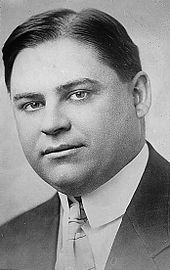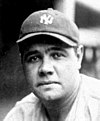Curse of the Bambino
The superstition was named after Babe Ruth, colloquially known as "The Bambino", who played for the Red Sox until he was sold to the New York Yankees in 1920.
Following the sale of Ruth, however, the once lackluster Yankees became one of the most dominant professional sports franchises in North America, winning more than twice as many World Series titles as any other MLB team.
On the 20th Anniversary of their World Series win, the sign was displayed on a duck boat during the Red Sox 2024 home opener parade.
[5] It became a key part of Red Sox lore in the media thereafter, and Shaughnessy's book became required reading in some high school English classes in New England.
Anxiety causes bad things to happen and the curse continues.” Although the title drought dated back to 1918, the sale of Ruth to the Yankees was completed January 3, 1920.
[7] In standard curse lore, Red Sox owner and theatrical producer Harry Frazee used the proceeds from the sale to finance the production of a Broadway musical, usually said to be No, No, Nanette.
As Leigh Montville wrote in The Big Bam: The Life and Times of Babe Ruth, the production No, No, Nanette had originated as a non-musical stage play called My Lady Friends, which opened on Broadway in December 1919.
Some of these instances are listed below: Red Sox fans attempted various methods over the years to exorcise their famous curse.
In Ken Burns's 1994 documentary Baseball,[full citation needed] former Red Sox pitcher Bill Lee suggested that the Red Sox should exhume the body of Babe Ruth, transport it back to Fenway and publicly apologize for trading Ruth to the Yankees.
Some declared the curse broken during a game on August 31, 2004, when a foul ball hit by Manny Ramírez flew into Section 9, Box 95, Row AA and struck a boy's face, knocking two of his teeth out.
[38] 16-year-old Lee Gavin, a Boston fan whose favorite player was Ramirez, lived on the Sudbury farm owned by Ruth.
Just after being traded to the Red Sox, Curt Schilling appeared in an advertisement for the Ford F-150 pickup truck hitchhiking with a sign indicating he was going to Boston.
[44] But the team tied the game with a walk by Kevin Millar and a stolen base by pinch-runner Dave Roberts, followed by an RBI single against Yankee closer Mariano Rivera by third baseman Bill Mueller, and won on a two-run home run in the 12th inning by David Ortiz.
[45] The Red Sox then faced the St. Louis Cardinals, the team to whom they had lost in 1946 and 1967, and led throughout the series, winning in a four-game sweep.
[46] Cardinals shortstop Édgar Rentería, who wore the same number as Ruth (3), was the final out of the series, a ground ball back to pitcher Keith Foulke.


